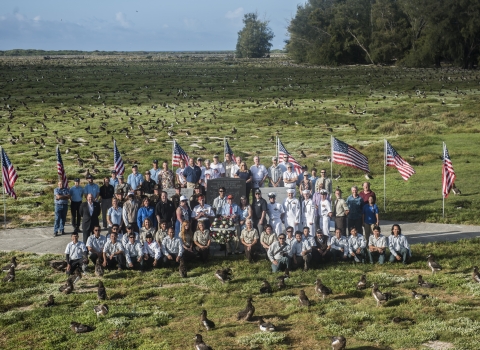The U.S. Fish and Wildlife Service’s Aquatic Animal Drug Approval Partnership Program collects data and conducts research to aid in the Food and Drug Administration’s aquatic drug approval process. It is the only program in the United States which is dedicated to obtaining safe and effective medications to improve fish culture and fisheries management practices.
In addition to conducting research on the safety and efficacy of aquatic drugs, the program also works with the FDA to provide fisheries professionals with legal access to Investigational New Animal Drugs (INAD), or otherwise unavailable treatment options which are still making their way through the drug approval process. These include medicated feeds, immersion baths, sedatives, spawning aides, marking, and injectable theraputics. All INAD treatments have a required withdrawal period that ensures the drug to leave the fish’s system prior to release ensuring the treated fish will not be harmful to the environment or a potential consumer.
A Rx for Conservation
The United States Fish and Wildlife Service is dedicated to the conservation of fish and the waters where they live. Our Fish and Wildlife Conservation Offices are at the forefront of monitoring the health and stability of fish populations across the country, and national fish hatcheries play an important role in conservation by raising aquatic wildlife that are at-at risk or endangered, improving recreational fishing, and supporting fisheries that have been impacted by a federal dam.
Just like in human populations, fish diseases can emerge and spread naturally, or they can be unintentionally spread from one population of fish to another. As climate change climate change
Climate change includes both global warming driven by human-induced emissions of greenhouse gases and the resulting large-scale shifts in weather patterns. Though there have been previous periods of climatic change, since the mid-20th century humans have had an unprecedented impact on Earth's climate system and caused change on a global scale.
Learn more about climate change increases water temperatures, emerging aquatic diseases could become more prolific in freshwater ecosystems and spread into new areas. Additionally, many aquatic ecosystems are experiencing habitat changes which can result in the loss of natural spawning cues and interrupt spawning cycles. We take extraordinary measures is to ensure the health and safety of the wild fish we study as well as the captive animals under our care - particularly in hatchery settings where large numbers of fish congregate and there is regular movement between captive to wild populations. One of those measures is the use and development of aquatic medications that are known to be safe for the animal treated, the environment, and for a potential consumer.
Stocking the Medicine Chest of the Future
Medicated feeds and immersion treatments – these medications treat internal/external bacteria or parasites. Medicated feed provides the medicine in the form of fish feed while immersion INADs are added to a water bath where fish absorb the medication through their skin. Both treatment types may be used in an aquaculture setting and can help prevent a mass mortality event once a disease or parasite is detected.
Sedatives – sedatives/anesthetics are used to reduce stress associated with the handling of fish and to decrease injury to both the fish and the handler. There are numerous scenarios where fish may need to be handled, and when this occurs it is safer and less stressful for the fish to be sedated. In aquaculture sedatives may be used to aid in spawning, transferring large fish, or conducting fish health inspections. In the field sedatives can aid in the collection of population metrics (i.e., length, weight, sex) or to surgically implant a tag for tracking purposes.
Spawning aides – spawning aides are used to induce spawning in fish which may not spawn on their own. The hormonal changes which enable fish to spawn are caused by environmental cues. In situations where these environmental cues no longer exist, due to habitat changes/loss or aquaculture rearing conditions, spawning aides can be used to simulate the hormone response needed for spawning to occur. Spawning aids are crucial to the success of threatened or endangered populations reared in captivity.
Marking – Some aquaculture programs rely on marking fish to determine the success of the stocked population. Fisheries biologists can then check fish for the mark upon recapture which helps them to collect survival information as well as an estimation of natural spawning occurring in the population (i.e., capturing juvenile fish without a mark would indicate that fish was naturally spawned).
Injectable Theraputics– Injectable therapeutics are most commonly used in returning salmon (i.e., hatchery-reared fish which return to the hatchery to spawn). Salmon have a unique lifecycle where they migrate to the ocean for majority of their life and return to their natal stream to spawn. Hatchery-reared salmon will return to the hatchery where they were released. The migration from the ocean to the natal stream or hatchery is physiologically stressful and often results in the fish becoming more susceptible to naturally caused diseases and pathogens. If the returning salmon are infected with pathogens upon arrival at the hatchery, injectable therapeutics enable the fish to remain healthy to spawn. Salmon naturally die after spawning. Therefore, treated salmon will not returned to the environment.
Improving Aquaculture and Fish Health for Conservation and our Partners
The INAD Program is available to all fisheries professionals within the United States that are willing to follow the study protocol approved by the FDA and meet AADAP’s data reporting requirements. The use of INADs generates important data demonstrating the safety and effectiveness of treatments that occur in controlled and experimental conditions which aides in the drug’s approval process. Aquaculture is a growing industry and AADAP is just one of the programs the USFWS has developed to ensure the safety and preservation of aquatic ecosystems. When fisheries professionals have more options for medications, they are better equipped to rear healthy fish, manage healthy aquatic populations, and maintain a healthy environment.


